UPDATE: Washington’s middle housing bill didn’t pass in 2022, but we anticipate a follow up in 2023, sign up here for updates. New polling finds finds 61% of voters across Washington state support legalizing middle housing, with 41% strongly supporting. Download a condensed version of this article here.
Washington’s worsening housing crisis calls for an all-hands-on-deck response from the state. The core reason more and more Washingtonians cannot find homes they can afford is that there aren’t enough homes to go around. And a big reason for that is widespread local bans on everything but stand-alone houses on large lots.
This January, the Washington state legislature will have a chance to correct that problem by establishing statewide standards for modest homes like triplexes and rowhouses, much like neighbors Oregon and California have recently done.
Governor Inslee’s request legislation—companion bills HB 1782 and SB 5670—sponsored by Sen. Mona Das and Rep. Jessica Bateman, would legalize “middle housing” in cities throughout the state—that is, the spectrum of housing options that exist between detached, stand-alone houses and large apartment buildings, options that serve a broader range of people and families. For details on the bill, see this follow up article. In brief, the bill would legalize:
- Sixplexes within a half-mile of transit and fourplexes everywhere else in cities with population of 20,000 or more
- Duplexes everywhere in cities with population of 10,000 or more
Here are 18 reasons why Washington should lift exclusionary zoning laws by passing HB 1792 and SB 5670:
MORE HOMES FOR PEOPLE WHO NEED THEM
1) Re-legalizing middle housing will help fix the root cause of Washington’s housing crisis: a shortage of homes. From 2010 to 2019, Washington added jobs twice as fast as it added housing, forcing Washingtonians to bid against each other for existing homes. A primary cause of the shortage is exclusionary zoning laws that ban middle housing from some three-quarters of the state’s residential land.
2) Re-legalizing middle housing will help reverse the driver of economic displacement: prices and rents propelled skyward by the statewide housing shortage. Widespread bans on middle housing throughout the state are a major barrier to meeting the demand for enough homes, and more home types near jobs, schools, and transit.
3) Historically, many cities enacted bans on middle housing to exclude Black Americans, and today those bans continue to segregate neighborhoods by race and class. Re-legalizing middle housing will take important steps toward correcting those historic wrongs and creating neighborhoods more welcoming to people of all incomes.
4) Middle housing is inherently less expensive than stand-alone houses because the homes are smaller and the cost of land is split between a few households. In contrast, detached-house zoning guarantees that only the most expensive kind of homes can ever get built in most residential neighborhoods.
5) Middle housing types such as townhouses and rowhouses boost home ownership options. Washington has an especially acute shortage of affordable for-sale homes because the vast majority are detached houses on large lots, as mandated by zoning laws. Re-legalizing middle housing will increase the supply of for-sale homes and lower their cost.
6) Re-legalizing middle housing will result in the slow and incremental addition of modest multi-dwelling homes to existing communities. In many residential neighborhoods, middle housing is only a return to historic roots in diverse housing types for a diversity of residents, family types, and incomes. Under status quo detached-house zoning, the prevailing change is modest older homes replaced by pricey McMansions.
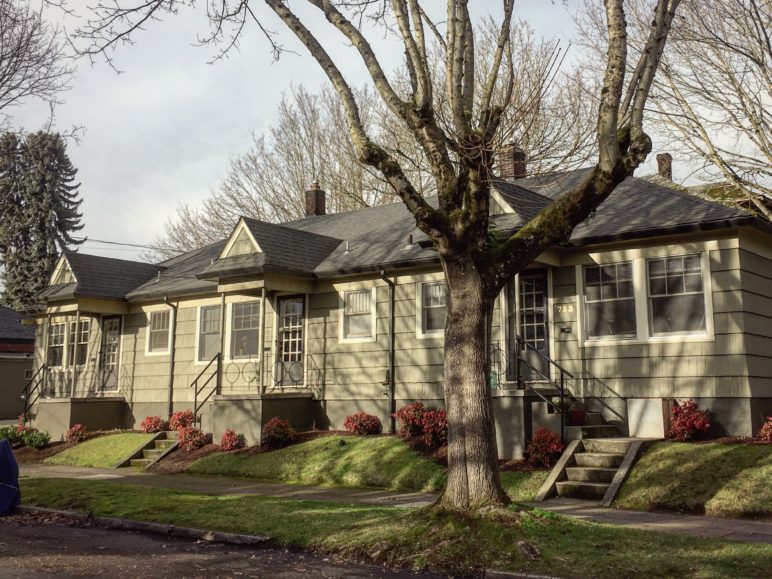
Triplex in Portland’s Irvington neighborhood. Photo by Dan Bertolet.
MORE SUSTAINABLE COMMUNITIES (AND LESS SPRAWL)
7) Re-legalizing middle housing will reduce sprawl, yielding numerous environmental and community benefits. Allowing more homes in existing neighborhoods eases the pressure to build new homes on farm and forest lands further out.
8) Re-legalizing middle housing will reduce infrastructure costs overall. Building the new infrastructure required to serve new houses spread out across previously undeveloped land is far more costly than tapping into existing infrastructure for infill homes. Incrementally rising demand for urban infrastructure is nothing that growing cities haven’t managed in the past.
9) Re-legalizing middle housing will reduce polluted stormwater runoff because new construction must adhere to stringent, modern environmental laws, typically yielding less runoff compared with the older structures replaced. A win for more housing choices is also a win for keeping the state’s waterways and salmon habitat healthier.
10) Re-legalizing middle housing allows more homes on less land, and that leaves more land for trees and greenspaces. Seattle has demonstrated that adding apartments and adding trees can go hand-in-hand. Adding middle housing to areas already urbanized will reduce development pressure outside cities and help preserve actual forests—where trees are most valuable for both habitat and carbon sequestration.
11) Middle housing is inherently more energy-efficient than stand-alone houses because the homes are smaller and share walls. Replacing three detached houses with a duplex, a triplex, and a fourplex can cut a typical city block’s carbon impact by 20 percent.
12) Re-legalizing middle housing will help neighborhoods become less car-dependent. Welcoming more neighbors creates walkable communities that can support more local shops and better transit. And the easier it is to live without a car, the lighter our carbon footprint, and the less we have to worry about parking and traffic, too.
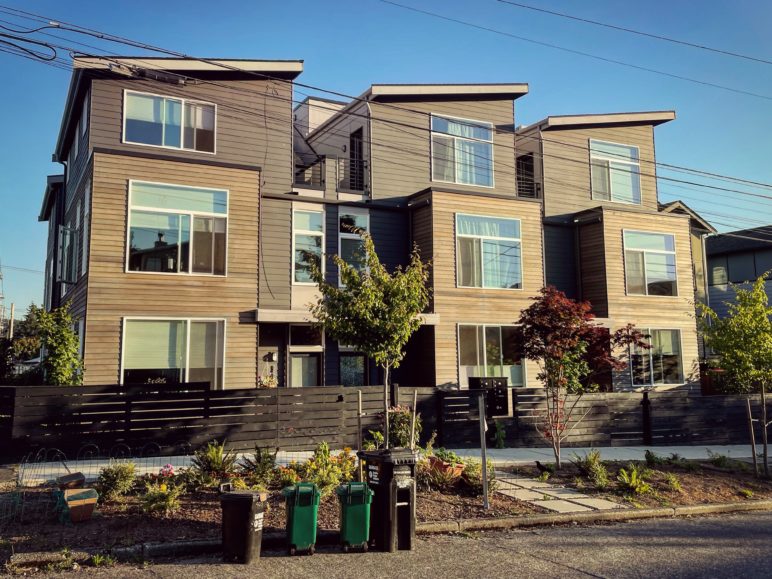
New rowhouses in Seattle’s West Woodland neighborhood. Photo by Dan Bertolet.
MORE STATEWIDE COLLABORATION AND RESOURCE-LEVERAGING
13) A statewide housing crisis calls for statewide solutions. Local governments created the zoning that excludes low-income families from communities all across Washington. Today, local leaders are stuck in the same dynamic that impedes action on climate change: mutual progress depends on all jurisdictions acting on zoning reforms together.
14) Washington’s Growth Management Act (GMA) has been effective at slowing sprawl but ineffective at supporting the necessary complement: infill housing in urbanized areas. The urgency of the housing crisis justifies establishing new statewide standards to allow more homes in residential neighborhoods.
15) One of the most agreed-upon principles in urban planning is the need to concentrate new housing in existing urban areas. Legalizing middle housing is a relatively low-impact change that would set a statewide baseline for allowing infill home choices. In cities throughout the state, some of the most desirable neighborhoods have a diverse mix of detached houses and middle housing.
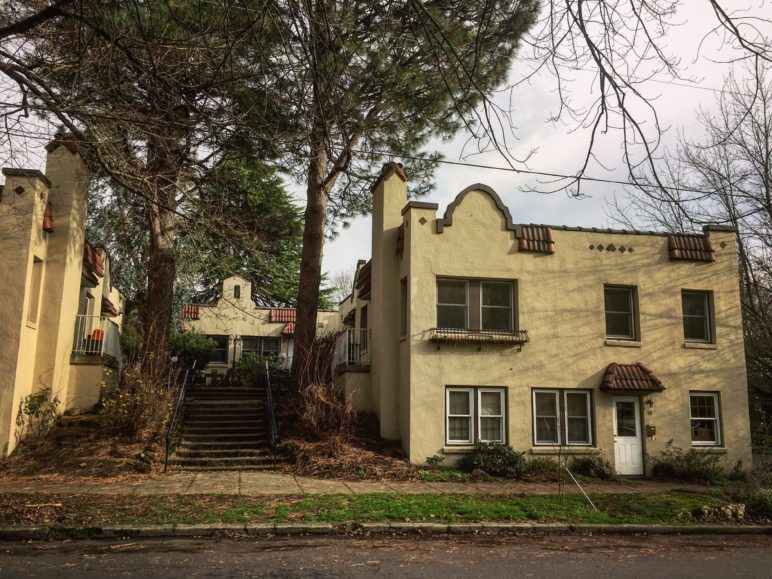
Courtyard apartment in Portland’s Irvington neighborhood. Photo by Dan Bertolet.
MORE BOONS FOR LOCAL BUSINESSES
16) Re-legalizing middle housing would benefit our local builders. Small-scale community-based builders, rather than deep-pocketed national developers, typically construct middle housing. Unfortunately, zoning laws only allow middle housing on a sliver of the land in most cities. Furthermore, the current wave of outside corporate speculation in detached houses is fueled by bans on middle housing, because those bans create the scarcity of homes that ensures ever-rising prices.
17) Re-legalizing middle housing will spur home-building that wouldn’t have happened otherwise. Besides creating well-paying construction jobs, that new construction generates increased sales and property tax revenues for local governments.
18) Middle housing is a workforce housing solution that helps keep cities across Washington affordable for moderate-income, working families and small households like seniors or young couples. Middle housing gives workers like more options to live in the communities they serve.
Addressing Washington’s statewide housing shortage and lifting bans on middle homes in the heart of our communities will not only stabilize out-of-reach prices—it will lift up rather than push out people who make their livelihoods in state job centers. These steps will also lay a foundation for addressing the overlapping challenges we face, maximizing the possibility for investments in affordable housing, anti-sprawl protections, climate emissions reductions, and preventing homelessness.
Click here if you’d like to learn more or get engaged on Washington’s efforts to end exclusionary zoning.

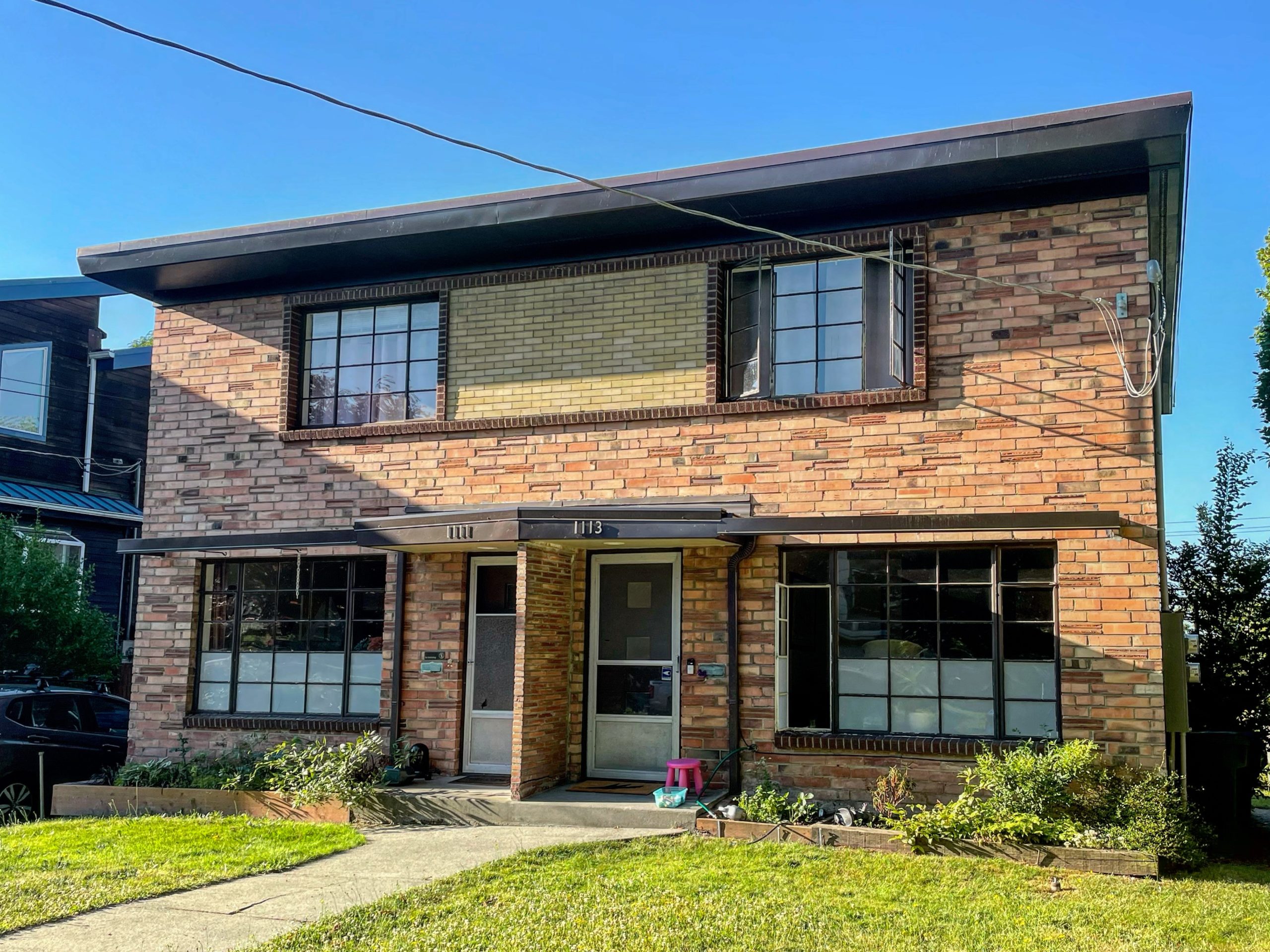
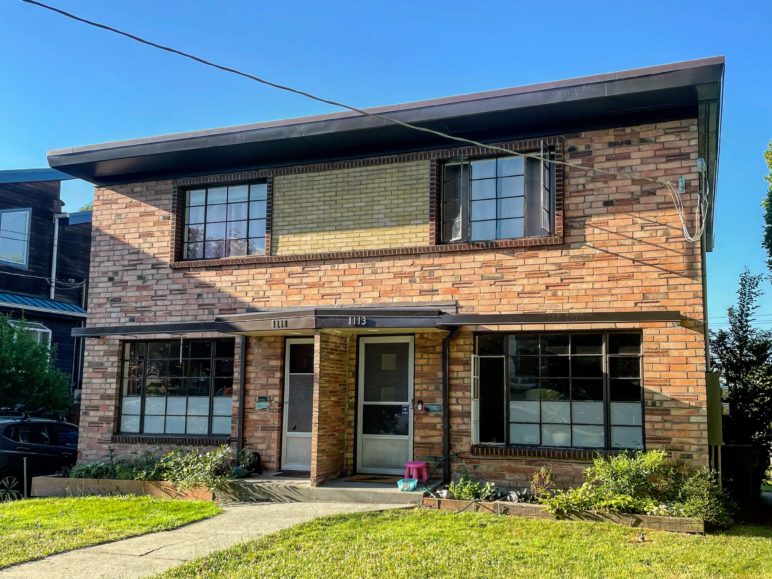







Frank
All the growth projections — jobs, transportation, housing needs, population, etc. — used for Vision 2050 are from before remote working became a dominant employment reality here. People are not going to move here “for jobs.” Jobs are not going to be located downtown. Transit use is, and will continue to be, a shadow of what the forecasts assume because of remote working. Before broad upzoning within the constructs of the GMA and local comp planning is done the assumptions need to be reevaluated.
Greg
The impact of remote work on housing varies by market. The Spokane region has experienced some significant growth during the pandemic as employees of Seattle and Portland based employers are able to relocate here due to the ability to work remotely. The OFM numbers are definitely off as a result. This has significant upward pressure on our housing prices and more housing is definitely needed, including missing-middle housing.
Luke
You assume that remote work is here to stay. Assuming we can get our collective act together and get the pandemic under control, employers will resume in-person work for a wide variety of reasons. Additionally, transit is useful for things other than work. Especially in a metro region as blessed with natural beauty and cultural attractions as Seattle, being able to take a hypothetical tram in a suburb to a Link station into downtown out to the sound ought to be not only more appealing from a lifestyle perspective than having to sit in traffic and pay for parking, but is certainly far more environmentally and economically-friendly.
Eric
Why is it important to prove beyond a reasonable doubt that housing is likely to be built before changing the zoning to allow it? What if we end up zoning for ten times the housing that anybody ends up actually wanting to build? Would that be such a bad thing?
Thom Woods
Why? Answer: Because historic local government practice has been to up zone “key priorities” rather than large swaths of their land base. Unless the up zoning is broad it will artificially inflate the value of a few properties (based on development potential) which allows land speculators to purchase and re-sell ‘ideas’ that drive up the costs of the land and has impacts on the assessed values of surrounding neighborhoods. The solution is to permit large upzoning (e.g. modernize zoning bylaws and upzone all single-family only areas subject to sufficient infrastructure)
Dan Bertolet
Eric, please back up your claim about the timber industry with some evidence or we’ll need to take your comment down, sorry.
Jeff Sea Builder & Realtor
The Seattle building department SDCI. currently takes 10 months for the fastest new home permit and 18 months for many of the multi family permits. A simple correction on plans has to wait about four weeks for the most simple change that takes about 15 minutes this is totally unacceptable and adds major costs $$$ and risks involved in holding a property 2 to 4 years for a builder we have lots of property currently zoned for new construction houses but many builders like me don’t want to take a risk two to four years into the future. Why can’t we get a building permit in two months like you can and some other states? Just hire more staff look at all the waste provide some more jobs and use our technology to make everything go much faster and you’ll see housing prices come WAY down with a lot more supply on the market the building department is actually causing most of this problem.
Duc pham
Agree
Lou B
I’m certain the Seattle Developers LOVE your piece (by design, and by contract, perhaps?), but you’re not doing your case any favors by including a bunch of New York Times links which, not being a subscriber, I can’t read. Similarly, the claims based on anecdotal assertions (ie Krugman), don’t hold much water either.
I wonder why you’re not including the positive housing advantages enabled by ADU’s, Tiny Houses, etc., especially when the article has search tags boasting such.
Nor do you say anything about increasing low-burden entry to the housing market via Home-sharing, as is recommended in the 1982 report from the President’s Housing Commission, which says:
“Obtaining additional income through sharing
of the space in one’s home is not a new idea, but it is
one of the ways in which elderly homeowners can
use their resources to meet needs for cash and for
companionship and assistance while maintaining a
home.”
An answer to “Why Not?” mention these is because these strategies, while effective in improving housing numbers, DON’T line developers pockets with millions of dollars from new, unregulated, unlimited in height & sprawl Mega-complexes.
The article’s oversight by NOT covering the much-needed LIMITS on the city-wide developments you’re advocating for leaves the impression of a bias in favor of unregulated housing and construction.
We’ve actually tried that before; they were called “The Projects”. Is that your great, new idea?